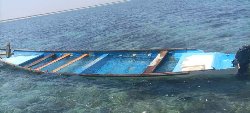200 people drown each day in the Western Pacific Region
200 people drown each day in the Western Pacific Region
MANILA, 18 November 2014 – More than 200 people drown each day in low- and middle-income countries in the Western Pacific Region, according to the World Health Organization's (WHO) latest report on injury prevention, Global report on drowning: preventing a leading killer.
The report identifies drowning as a leading cause of death in young people. Drowning is the most common cause of death in children aged 5–14 years in the Western Pacific Region. Our Region accounts for 20% of global drowning deaths.
More than 73 000 people drowned in low- and middle-income countries of the Region in 2012. However, this figure does not include drowning deaths related to suicide, homicide, natural disasters such as typhoons and flooding and water transport disasters. The report highlights that these additional causes can increase the global burden of drowning by a further 50%.
"Our Region
has made tremendous progress towards the Millennium
Development Goal 4 target of a two thirds reduction in
under-five child mortality by 2015" said
Dr Shin
Young-soo, WHO Regional Director for the Western Pacific.
“In doing so, the impact of more hidden causes of death in
children such as drowning have become more apparent,” he
said.
The underlying message of this milestone first report is that drowning can be prevented. Interventions such as installing barriers to control access to water; providing safe places for children while their parents work; teaching children basic swimming skills and training bystanders in safe rescue and resuscitation have all shown great promise at preventing drowning at the community level. At the national level, enforcement of safety regulations for water transport vessels; building flood resilience and comprehensive water safety policies must be enacted.
The global report describes drowning prevention projects in a number of low- and middle-income countries including Cambodia, China, the Philippines and Viet Nam. The report recommends systematic implementation and monitoring of efforts to identify best practices and scale up successful interventions.
“The evidence-based community actions recommended by WHO could save the lives of tens of thousands of the most vulnerable children in our Region,” concluded Dr Shin.
Related links:
Global report on drowning: preventing a leading killer
http://www.who.int/violence_injury_prevention/global_report_drowning/en/
Fact sheet: Drowning
http://www.who.int/mediacentre/factsheets/fs347/en/
ENDS


 UN News: Ceasefire The Only Way To End Killing And Injuring Of Children In Gaza
UN News: Ceasefire The Only Way To End Killing And Injuring Of Children In Gaza ICHRP: US-Japan-Philippines Trilateral Summit Makes The Philippines A Battlefield For US-China Conflict
ICHRP: US-Japan-Philippines Trilateral Summit Makes The Philippines A Battlefield For US-China Conflict East West Center: Environmental Journalist Alexander Kaufman Receives East-West Center’s Inaugural Melvin M.S. Goo Writing Fellowship
East West Center: Environmental Journalist Alexander Kaufman Receives East-West Center’s Inaugural Melvin M.S. Goo Writing Fellowship Compassion in World Farming: Octopus Farm Must Be Stopped, Say Campaigners
Compassion in World Farming: Octopus Farm Must Be Stopped, Say Campaigners UN News: Shipwreck Tragedy Off Djibouti Coast, Drone Attacks Continue At Ukraine Nuclear Plant, Madagascar Cyclone Update
UN News: Shipwreck Tragedy Off Djibouti Coast, Drone Attacks Continue At Ukraine Nuclear Plant, Madagascar Cyclone Update UN News: Aid Lifeline Reaches Sudan's Darfur Region In Bid To Avert ‘Hunger Catastrophe’
UN News: Aid Lifeline Reaches Sudan's Darfur Region In Bid To Avert ‘Hunger Catastrophe’